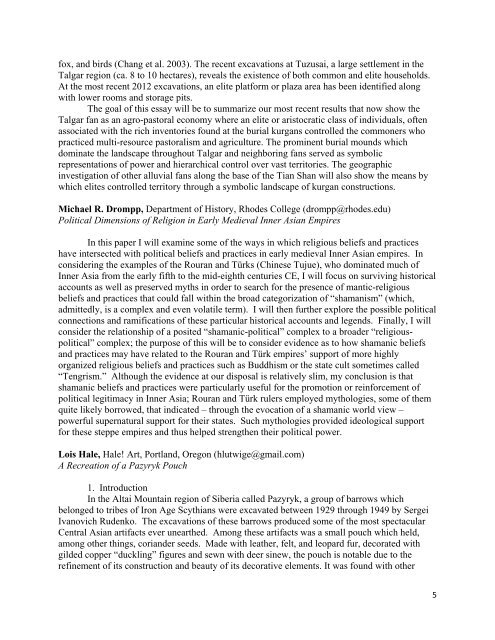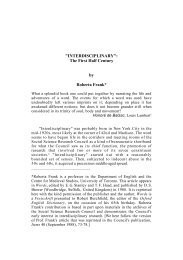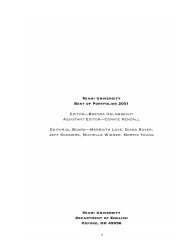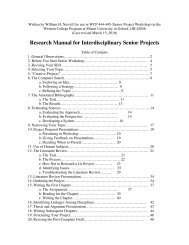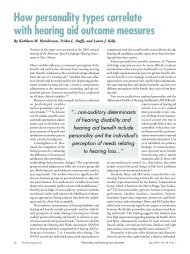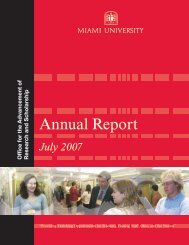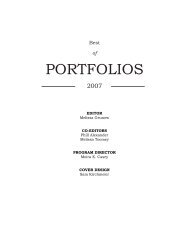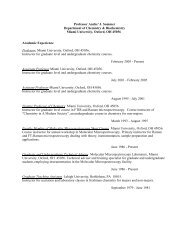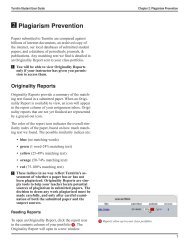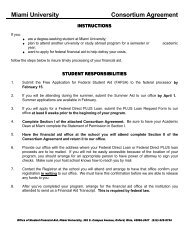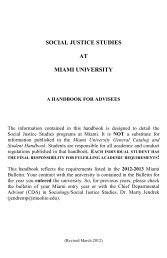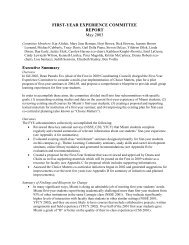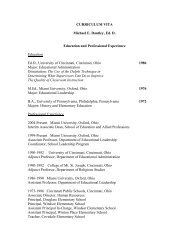The Steppes: Crucible of Eurasia - units.muohio.edu - Miami University
The Steppes: Crucible of Eurasia - units.muohio.edu - Miami University
The Steppes: Crucible of Eurasia - units.muohio.edu - Miami University
You also want an ePaper? Increase the reach of your titles
YUMPU automatically turns print PDFs into web optimized ePapers that Google loves.
fox, and birds (Chang et al. 2003). <strong>The</strong> recent excavations at Tuzusai, a large settlement in the<br />
Talgar region (ca. 8 to 10 hectares), reveals the existence <strong>of</strong> both common and elite households.<br />
At the most recent 2012 excavations, an elite platform or plaza area has been identified along<br />
with lower rooms and storage pits.<br />
<strong>The</strong> goal <strong>of</strong> this essay will be to summarize our most recent results that now show the<br />
Talgar fan as an agro-pastoral economy where an elite or aristocratic class <strong>of</strong> individuals, <strong>of</strong>ten<br />
associated with the rich inventories found at the burial kurgans controlled the commoners who<br />
practiced multi-resource pastoralism and agriculture. <strong>The</strong> prominent burial mounds which<br />
dominate the landscape throughout Talgar and neighboring fans served as symbolic<br />
representations <strong>of</strong> power and hierarchical control over vast territories. <strong>The</strong> geographic<br />
investigation <strong>of</strong> other alluvial fans along the base <strong>of</strong> the Tian Shan will also show the means by<br />
which elites controlled territory through a symbolic landscape <strong>of</strong> kurgan constructions.<br />
Michael R. Drompp, Department <strong>of</strong> History, Rhodes College (drompp@rhodes.<strong>edu</strong>)<br />
Political Dimensions <strong>of</strong> Religion in Early Medieval Inner Asian Empires<br />
In this paper I will examine some <strong>of</strong> the ways in which religious beliefs and practices<br />
have intersected with political beliefs and practices in early medieval Inner Asian empires. In<br />
considering the examples <strong>of</strong> the Rouran and Türks (Chinese Tujue), who dominated much <strong>of</strong><br />
Inner Asia from the early fifth to the mid-eighth centuries CE, I will focus on surviving historical<br />
accounts as well as preserved myths in order to search for the presence <strong>of</strong> mantic-religious<br />
beliefs and practices that could fall within the broad categorization <strong>of</strong> “shamanism” (which,<br />
admittedly, is a complex and even volatile term). I will then further explore the possible political<br />
connections and ramifications <strong>of</strong> these particular historical accounts and legends. Finally, I will<br />
consider the relationship <strong>of</strong> a posited “shamanic-political” complex to a broader “religiouspolitical”<br />
complex; the purpose <strong>of</strong> this will be to consider evidence as to how shamanic beliefs<br />
and practices may have related to the Rouran and Türk empires’ support <strong>of</strong> more highly<br />
organized religious beliefs and practices such as Buddhism or the state cult sometimes called<br />
“Tengrism.” Although the evidence at our disposal is relatively slim, my conclusion is that<br />
shamanic beliefs and practices were particularly useful for the promotion or reinforcement <strong>of</strong><br />
political legitimacy in Inner Asia; Rouran and Türk rulers employed mythologies, some <strong>of</strong> them<br />
quite likely borrowed, that indicated – through the evocation <strong>of</strong> a shamanic world view –<br />
powerful supernatural support for their states. Such mythologies provided ideological support<br />
for these steppe empires and thus helped strengthen their political power.<br />
Lois Hale, Hale! Art, Portland, Oregon (hlutwige@gmail.com)<br />
A Recreation <strong>of</strong> a Pazyryk Pouch<br />
1. Introduction<br />
In the Altai Mountain region <strong>of</strong> Siberia called Pazyryk, a group <strong>of</strong> barrows which<br />
belonged to tribes <strong>of</strong> Iron Age Scythians were excavated between 1929 through 1949 by Sergei<br />
Ivanovich Rudenko. <strong>The</strong> excavations <strong>of</strong> these barrows produced some <strong>of</strong> the most spectacular<br />
Central Asian artifacts ever unearthed. Among these artifacts was a small pouch which held,<br />
among other things, coriander seeds. Made with leather, felt, and leopard fur, decorated with<br />
gilded copper “duckling” figures and sewn with deer sinew, the pouch is notable due to the<br />
refinement <strong>of</strong> its construction and beauty <strong>of</strong> its decorative elements. It was found with other<br />
5


